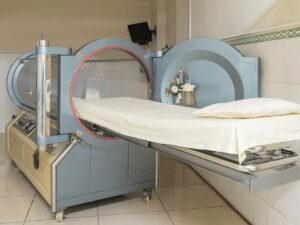Can you breathe pure oxygen? The short answer is yes, but it’s not recommended for prolonged exposure due to potential health risks.
As an expert in hyperbaric chamber technology, I’ve explored the effects of breathing pure oxygen across various medical and athletic scenarios.
In this guide, we will explore the benefits and risks of pure oxygen, how it’s used in hyperbaric treatments, and safety considerations for different user groups.
Read on and dive into breathing science!
Oxygen is a vital element that supports life on Earth. It makes up about 21% of the air we breathe and is essential for the survival of most living organisms, according to Brilliantio. In the atmosphere, oxygen exists mostly as a pair of oxygen atoms, which is the breathable form we commonly refer to as O2. This gas is colorless, tasteless, and odorless, making it undetectable without special equipment.
In its pure form, oxygen is highly reactive and plays a crucial role in various chemical and biological processes. Oxygen also participates in respiration by which cells derive energy from nutrients. Understanding these basic properties of oxygen helps us appreciate its importance and manage its use in medical and industrial settings. Here’s why that’s important, it underlines the dual nature of oxygen as both vital and volatile.
Building on our understanding of oxygen, it’s important to consider how breathing pure oxygen affects the body. Here are the key physiological effects:
Breathing pure oxygen can significantly affect cellular function. Cells use oxygen to produce energy, and an increased supply can accelerate this process. So what’s my point? This can lead to enhanced healing and recovery rates, particularly useful in medical treatments. However, excess oxygen can also lead to the production of free radicals, which may damage cells.
Increased oxygen in the blood can improve circulation and the efficiency of the cardiovascular system. This can be particularly beneficial for patients with circulatory issues or heart conditions. Enhanced oxygen levels help in better delivery of nutrients and removal of waste products from cells. However, prolonged exposure to high oxygen levels can stress the cardiovascular system.
High levels of oxygen can also impact brain function. Initially, it may enhance cognitive abilities, improving alertness and reaction times. Here’s the interesting part, this is why pure oxygen is sometimes used by athletes and in emergency medical situations. Over time, however, too much oxygen can lead to disorientation and other negative cognitive effects.

Following our exploration of the physiological effects of breathing pure oxygen, it’s evident that pure oxygen has several important roles in medical treatment. Here are some of its primary medical uses:
Pure oxygen is often used in hyperbaric oxygen therapy (HBOT), where patients breathe 100% oxygen in a pressurized chamber. This therapy helps accelerate the healing of wounds, particularly for diabetic foot ulcers and burns. It also aids in fighting certain types of infections by enhancing the body’s immune response. The high-oxygen environment lets more oxygen dissolve in the bloodstream, reaching areas that are hard to heal.

In emergency medical situations, administering pure oxygen can be life-saving. Now, this is important, it is used to manage hypoxia (low body oxygen) until more specific treatments can be applied. For example, patients with carbon monoxide poisoning are treated with high levels of oxygen to displace the carbon monoxide from red blood cells. This approach rapidly restores normal oxygen transport in the blood.

For newborns experiencing difficulties in breathing or who are born prematurely, pure oxygen is administered to support their fragile respiratory systems. This intervention helps stabilize oxygen levels in the blood, promoting overall survival rates in the critical first days of life. Sound good? The controlled use of oxygen must be carefully monitored to avoid any potential damage to the infant’s developing eyes and lungs.

While the medical uses of pure oxygen are numerous, it’s essential to be aware of potential risks and side effects. Here are the key concerns:
Breathing pure oxygen at high pressures for prolonged periods can lead to oxygen toxicity. As if that’s not enough, this condition causes symptoms like nausea, twitching, dizziness, and disorientation. In severe cases, it can result in lung damage or central nervous system effects, including seizures. This is often a concern during hyperbaric oxygen therapy or deep-sea diving.
High concentrations of oxygen, particularly over long periods, can damage the delicate tissues of the lungs. And on top of that, this damage can manifest as inflammation and scarring of lung tissue, a condition known as pulmonary fibrosis. Patients receiving long-term high oxygen therapy need regular monitoring to manage and mitigate this risk.
Extended exposure to high concentrations of oxygen can lead to vision problems, particularly in newborns receiving oxygen therapy. Known as retinopathy of prematurity, this condition can cause the blood vessels in the eyes to grow abnormally and erratically, potentially leading to blindness. It underscores the need for careful monitoring of oxygen levels in neonatal care.

Acknowledging the risks and side effects of breathing pure oxygen highlights the importance of strict implementation of safety measures. Here are essential precautions to take:
Ensuring good ventilation in areas where pure oxygen is used is crucial to prevent oxygen accumulation, which can heighten fire risks. Facilities should have ventilation systems that regularly exchange indoor and outdoor air to maintain safe oxygen levels. This practice helps dilute any potential oxygen buildup. Oxygen-ark provides advanced ventilation solutions that enhance safety in environments utilizing pure oxygen.
Strict fire safety protocols must be in place wherever pure oxygen is used or stored. This includes banning smoking and avoiding the use of open flames or spark-generating equipment near oxygen sources. Here’s the bottom line, facilities should have fire extinguishers readily available and staff trained in their use, as oxygen can dramatically increase the intensity of a fire.
Regular maintenance and inspection of oxygen delivery systems and storage units are essential to guarantee they function safely. Leaks in the system can lead to oxygen build-up, which is dangerous. Scheduled checks and repairs of equipment like regulators and tanks to prevent malfunctions. Oxygen-ark specializes in providing durable and reliable oxygen delivery systems that secure operational safety and efficiency.
Staff and users should receive thorough training on the safe handling and use of pure oxygen. They should understand the physiological effects, potential hazards, and first aid responses in case of oxygen-related incidents. It all boils down to this. For example, employees in a hospital setting must know how to adjust oxygen flow rates correctly and what to do in the event of oxygen toxicity symptoms.

Moving from safety measures for using pure oxygen, it’s also vital to address and clarify common misconceptions. Here are some prevalent myths and the facts that debunk them:
After debunking common beliefs about pure oxygen, it’s helpful to explore alternative methods that can enhance oxygen intake without using pure oxygen. Here are some effective alternatives:
Enhanced air filtration systems improve indoor air quality by removing pollutants and increasing the oxygen content. These systems are particularly useful in urban settings or areas prone to pollution. In a similar fashion, by breathing cleaner air, patients can experience improved oxygen absorption. This method is non-invasive and can be used continuously without the risks associated with pure oxygen.
Various breathing techniques can increase oxygen uptake and improve lung efficiency. Practices like deep breathing and diaphragmatic breathing are often used in yoga and meditation. These methods help in better oxygenation of the blood and can be particularly beneficial for improving overall respiratory health. Regular practice can enhance lung capacity and optimize the body’s use of available oxygen.
Certain dietary supplements and foods are known to improve blood oxygen levels. Ingredients like omega-3 fatty acids can enhance lung function. Foods rich in iron are critical for hemoglobin function, which is essential for oxygen transport in the blood. Here’s something we can both agree on, a balanced diet supports the body’s natural ability to use oxygen efficiently and can be a supportive measure alongside other methods.
Below is a table summarizing key dietary supplements and foods that improve blood oxygen levels, highlighting their specific benefits and sources.
| Supplement/Food | Primary Benefit | Common Sources |
| Omega-3 Fatty Acids | Enhances lung function | Fish oil, flaxseeds, walnuts |
| Iron | Essential for hemoglobin and oxygen transport | Red meat, spinach, lentils |
| Antioxidants | Protects cells from oxidative stress | Berries, nuts, dark chocolate |
| Vitamin C | Aids in the absorption of iron and reduces fatigue | Oranges, strawberries, bell peppers |
| Beetroot | Increases nitric oxide levels, improving blood flow and oxygen delivery | Beetroot juice, cooked beetroot |
For some insightful reads, we’ve curated a list of recommended articles just for you:
Still haven’t found what you’re looking for? Don’t hesitate to contact us. We’re available around the clock to assist you.
Breathing pure oxygen has both potential benefits and risks, depending on its application and context. This guide has explored the scientific and medical perspectives to help you understand when and how it can be safely used.
If your business is looking to explore the benefits of pure oxygen further, Oxygen-ark offers specialized assistance and hyperbaric chamber solutions fitted to your needs. For more information, please contact us.
Get in touch with us and unlock your full well-being potential!
The OxygenArk team is here to assist you every step of the way.